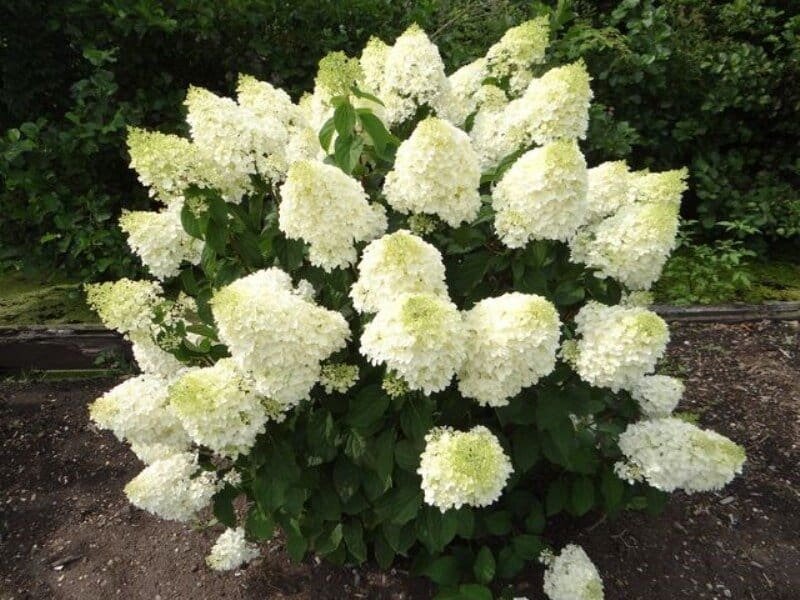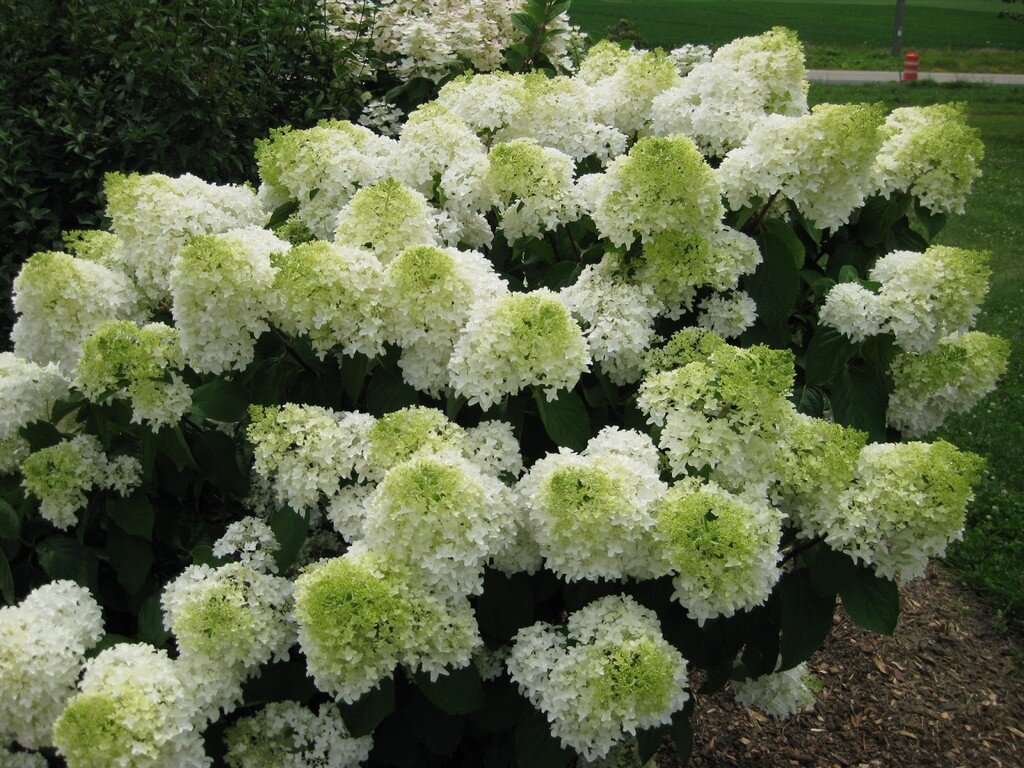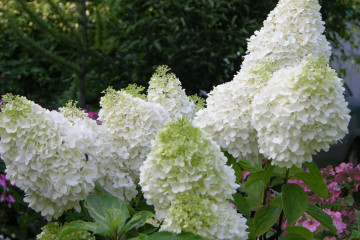Panicle hydrangea Silver Dollar - variety description
Content:
Lush and showy plant varieties always attract attention. Among gardeners, the paniculate hydrangea Silver Dollar plant is especially popular. The perennial shrub is distinguished by its unpretentiousness to growing conditions, it perfectly tolerates frosty winters and sultry summer weather. The plant has a stable immunity to diseases and damage of insect pests.
Description of the variety and its characteristics
Hydrangea Silver Dollar is a spreading shrub with a gorgeous crown. An adult bush reaches a height of 1.5 meters, in diameter - up to 2.5 meters. The bulkiness of a plant suggests a careful choice of a place for planting. The bush must be given enough space on the site.
Young stems of paniculata hydrangea are green, erect. With age, the shoots acquire a brown color. Leaves are dark green, slightly pointed. Dense, rounded inflorescences, when they appear, have a pale green tint, as the bush grows, they become white, and by the end of flowering they acquire a pinkish color.
History of origin
Flowering shrubs began to be grown in Southeast Asia. The plant was brought to European countries and to Russia in the 14th century. At the end of the 20th century, namely in 1990, experts bred the Silver Dollar panicle hydrangea variety. The name of the shrub translates as silver dollar.
Features of the variety
The Silver Dollar hydrangea has straight, powerful stems that do not bend under the weight of the lush flowering cap of the inflorescences. White flowers are pyramid-shaped. Most of the large flowers are sterile. The inflorescences that form the seeds are smaller in size.
The Silver Dollar hydrangea blooms in early July. The growing season lasts until the end of September. The plant is distinguished by abundant flowering. The mass and density of the inflorescences increase as the shrub grows.
Winter hardiness
The Silver Dollar hydrangea shrub is well adapted to low temperatures. In regions with moderate climatic conditions, the bushes calmly survive frosts down to -25 degrees without the use of covering material. When growing paniculata hydrangea in Siberia and the Urals, additional protection should be considered. In these regions, the temperature drops to 30-40 degrees below zero.
Planting and further care of hydrangea Silver Dollar
An unpretentious plant is grown in compliance with the rules on which the health of the bushes and the quality of flowering depend. It is important to choose the right planting site, as well as to provide basic care. The plant needs to be watered regularly, pruned and fertilized in a timely manner.
Site selection and preparation
Shrubs are not too demanding on the composition of the soil.Plants take root well on fertile, loamy and slightly acidic soil. The variety has a negative attitude towards calcareous soil, therefore, such soil must be mixed with humus and peat before planting. The hydrangea grows and blooms best in a shaded area.
How to plant
A hole should be dug to plant the plant. The recess should be 3 times the size of the seedling. The excavated soil must be mixed with sand and organic fertilizers. Step-by-step instructions for planting a bush:
- Drainage is laid at the bottom of the pit. The thickness of the layer of stones or pebbles should not be less than 15 cm.
- A little prepared earth should be poured on top.
- A seedling is placed vertically in the hole.
- The space around the shoot is filled with the remains of nutrient soil.
- After the end of planting, the land around the future shrub is mulched with fallen leaves or straw.
Watering and feeding
Regular watering and timely feeding are the main activities affecting the development of the bush. It is necessary to water the plant in summer every day or every other day if there is no rain outside. Water for irrigation must first settle. About 2-3 buckets of liquid are consumed per bush.
It is recommended to start feeding in the middle of spring. A little nitrogen is added to the water for irrigation, which helps to grow foliage. During the setting of inflorescences, you need to feed the flower with potassium-phosphorus fertilizers. At the end of flowering, citric acid or potassium permanganate solution can be added to the water for irrigation.
Pruning
It is recommended to prune the Silver hydrangea bushes in the spring. The procedure helps to free the shrub stem from dried and frozen shoots, as well as to form a beautiful crown. In the fall, after flowering, dried inflorescences must be cut off.
A rejuvenating type of pruning is carried out in the fall. To do this, all the stems must be completely cut off, and the root system must be well covered for the winter. This type of pruning is suitable for perennial shrubs with old shoots and inflorescences.
Preparing for winter
In order for the plant to withstand the winter weather well, you should prepare from the middle of autumn. After pruning, the bushes must be carefully protected with mulch. For this, hay, straw, leaves are used. For cold regions, it is recommended to equip protective frames around the bushes and cover them with foil.
Reproduction
The variety is bred in several ways:
- Layers. Layers are taken at the bottom of the bush, choosing strong stems.
- By dividing the bush. This method is used on large and fairly overgrown plants.
- By cuttings. The method consists in cutting the shoots into pieces of about 15 cm long. Cuttings are planted in containers before rooting. The seedlings are transferred to a permanent place in the spring.
Diseases and pests, ways to deal with them
Hydrangeas are not susceptible to disease, but if you do not follow the rules of cultivation, this will lead to problems. Excess water in the soil can provoke root rot and fungal infections. A weakened plant is more attractive to harmful insects.
Regular watering, top dressing and the right growing location will create ideal conditions for the healthy growth and development of the hydrangea bush.
Use in landscape design
Abundantly blooming hydrangeas look great as free-standing bushes and as part of landscape compositions. Variety Silver on a stem goes well with short plants in pink, purple or purple tones. Tall coniferous trees next to delicate hydrangea also look harmonious.
The hydrangea variety Silver is a strong and hardy shrub with pronounced decorative properties. Lush, gentle flowering of bushes will decorate any site, flower bed or city park.




















